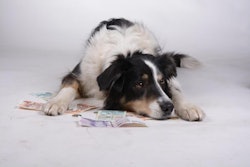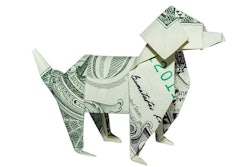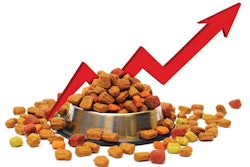
Good news about the health of the pet food market continues as we wrap up 2018. Sales of pet consumables — pet food and treats — in the U.S. reached US$32.7 billion for the 12 months ending in June 2018, according to a new report from Nielsen, representing 5 percent growth over the previous 12-month period. Not only did this increase help fuel “much-needed growth to the overall FMCG (fast-moving consumer goods) space,” the reports authors noted, but not surprisingly, online growth was especially robust. Wet pet food sales also provided a bright spot.
Pet food growth in most channels, especially online
At US$3.6 billion, pet food e-commerce now comprises 11 percent of the total U.S. pet food market; and those sales represented a whopping 53 percent rise over the previous 12 months. Growth in other channels was much lower: just 0.7 percent for brick-and-mortar pet stores (both superstores and neighborhood pet shops) and 1.7 percent for what Nielsen calls “mainstream retail.” Pet food sales in U.S. vet clinics even declined 5.8 percent.
Yet the market research firm does offer some hope to the traditional pet retail channel. At US$8 billion, its pet food sales are still more than double that of online. Plus, according to other Nielsen research, the Digital Shopping Fundamentals survey, 51 percent of U.S. pet owners said they don’t ever plan to shop for or purchase pet products online.
Pet owners seem particularly loyal to their neighborhood pet stores, which are the main reason the pet retail channel experienced any growth at all. “While pet superstores have seen declines in both volume and dollar sales, neighborhood pet retailers have continued to experience impressive dollar and volume growth,” Nielsen said.
The report added that independent pet stores have capitalized by driving sales of premium pet foods and meal enhancers; the latter category reached US$84 million in sales in this channel, representing 21 percent growth over the previous 12 months. Key sellers included bone broths and stews in cartons and pouches, according to Nielsen.
‘Mass premiumization’ of pet food continuing to have an impact
The mainstream retail channel, which presumably includes grocery stores and other mass market outlets, saw US$16 billion in pet consumables sales, at least partially due to the continued migration of premium pet foods into that channel. “Much like we see across the grocery channel, consumers no longer have to go far to find a premium assortment of pet products for their furry, scaly and feathered friends,” the Nielsen report said.
Though the report did not include a comparison with the previous 12 months for farm and feed stores, pet food sales in that channel reached an estimated US$3.5 billion, nearly as much as online. That figure matches the farm and feed pet food total for 2015 reported then by GfK, which said sales were growing 5 percent annually in that channel. With GfK recently being acquired by Nielsen, the US$3.5 billion cited now may still be based on the older data. Considering that large farm and feed retailers like Tractor Supply continue to expand their pet food assortment, including with their own lines, it would make sense that sales in that channel may actually be higher now.
Wet dog food on the rise
It’s important to note that, while Nielsen commented on volume growth in traditional pet stores, much of the pet food sales growth in the U.S. continues to come from premiumization — pet owners buying higher-priced consumables — rather than any meaningful volume increases. In fact, volume decreased 1 percent in mainstream retail, despite the nearly 2 percent increase in sales in that channel.
Spotlighting dog food sales, Nielsen said some product categories stood out. Wet dog food sales increased by 4.7 percent, compared to 2 percent for dog food overall, while product claims that have been resonating with pet owners for a while now still showed growth: 43 percent for natural dog food and 27 percent for dog foods claiming to be free of artificial colors. “Dry dog food continues to hold a commanding share of category sales, but growth has stagnated. As consumers’ hearts and wallets grow more fond of wellness regimes in pet care, the rise of wet pet food may continue,” the report said.
















